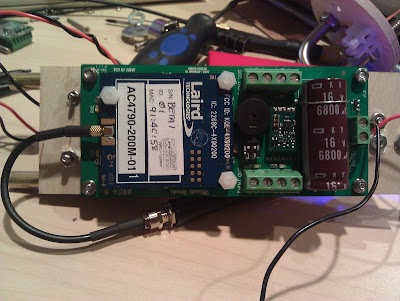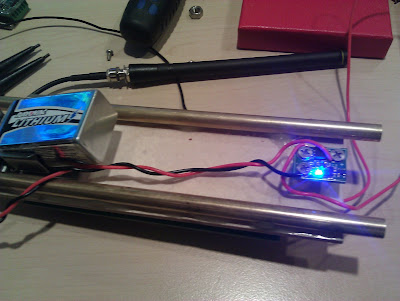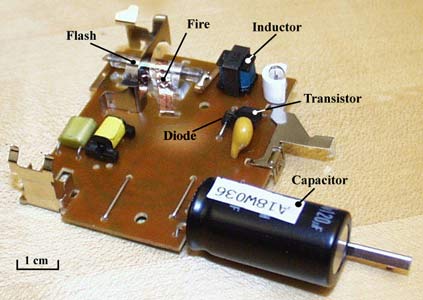I built a magnetic ejection system about 10 years ago
I thought I did a write-up, here on rocketryforum but can't seem to find it.... might have been rocketry planet
I have a copy/paste from an old blog post of mine, but much of the media and links seem to be missing. You get the idea too.
Still have a few rockets (including that pizza rocket) with magnetic ejection, and it works, but it's a lot of custom work to build into a rocket.
Fun with magnets!

After a particularly bad experience with BP, I thought there had to be a better solution to rocket recovery than initiating an explosion inside the rocket. I want hot gases to exit the nozzle, not the nosecone!
I’ve been playing with several third party solutions.
 The first was the Chute Tamer. This is a neat idea that uses fishing line to keep the parachute folded, then initiates a ‘cuter’ by heating up an element that melts the fishing line. The filament is initiated by a timer. I had two issues with the chute tamer. The first issue is it still required BP at apogee to pop the nosecone – either from a traditional altimeter, or motor ejection. Second, you have to do a fair amount of modeling and prediction to determine when the optimal time (vs. altitude) would be for main deployment. I started a conversation with the inventor, Warren Farr about replacing the timer with an altimeter. After a fair amount of back and forth, Warren was kind enough to sell me a few chute tamer’s that were modified to allow me to put my own electronics in. I spent a few months designing two alternatives
The first was the Chute Tamer. This is a neat idea that uses fishing line to keep the parachute folded, then initiates a ‘cuter’ by heating up an element that melts the fishing line. The filament is initiated by a timer. I had two issues with the chute tamer. The first issue is it still required BP at apogee to pop the nosecone – either from a traditional altimeter, or motor ejection. Second, you have to do a fair amount of modeling and prediction to determine when the optimal time (vs. altitude) would be for main deployment. I started a conversation with the inventor, Warren Farr about replacing the timer with an altimeter. After a fair amount of back and forth, Warren was kind enough to sell me a few chute tamer’s that were modified to allow me to put my own electronics in. I spent a few months designing two alternatives
 The second product I stumbled upon was a spacetec SRM. This is basically a release mechanism operated by a standard RC servo. What’s cool about it is the company sells a servo control unit that allows the SRM to be connected to a traditional altimeter. The SRM “Holds” the main in the rocket body until the altimeter determines it’s reached the proper altitude. A better solution than the chute tamer on multiple levels (uses an altimeter, no limit to the size chute, as it doesn’t use fishing line) but still requires BP to eject the nosecone.
The second product I stumbled upon was a spacetec SRM. This is basically a release mechanism operated by a standard RC servo. What’s cool about it is the company sells a servo control unit that allows the SRM to be connected to a traditional altimeter. The SRM “Holds” the main in the rocket body until the altimeter determines it’s reached the proper altitude. A better solution than the chute tamer on multiple levels (uses an altimeter, no limit to the size chute, as it doesn’t use fishing line) but still requires BP to eject the nosecone.
Finally, I hit upon an idea – what if I ejected the nosecone using electromagnets? I could easily build a circuit that would charge a very high voltage capacitor, then use an altimeter to initiate the capacitor circuit. I started doing some testing using an Este’s V2, and it worked! The nice thing about the V2 is it has a large diameter to fit all of the equipment, yet it’s really light. I was about to announce my invention to the world when I started having a series of failures starting at MWP 8. The system never failed, but the calculations I had been doing on repulsive magnetic force weren’t working – The electromagnets starting putting out such a large magnetic burst it was blowing the electronics out of the rocket. By now, I started work on my Level 3 certification and decided to put the electromagnetic ejection system on the back burner until I finished.
Fast Forward a year, and I finally found the right project to finish the system. I’ve been building “flying pie”, which is a spool pizza rocket for the last few months, but I found it very difficult to build a simulation to model its flight characteristics using traditional software. Add to this the fact it’s a 75mm minimum diameter motor tube, which means I can’t rely on motor ejection at all (no commercial 75mm motors have motor ejection). In the few flight trials, I did with the spool, the flight characteristics were so different than a traditional rocket the G switch timer, and altimeter had a hard time reliably detecting launch, and/or apogee.
 Around this time, Darrell Mobley at RocketryPlanet told me that Jim Amos at Missileworks was going to be building an updated version of his WRC wireless control system. The WRC allowed the rocketeer to take control of the ejection process using a remote control rather than relying on a traditional altimeter. This seemed to be the perfect solution to initiate recovery on a rocket that traditional altimeters had a hard time with. Jim was kind enough to let me into the beta program for his updated wrc+. I will dedicate another post to a review of the wrc+, but the one-line review is “awesome”.
Around this time, Darrell Mobley at RocketryPlanet told me that Jim Amos at Missileworks was going to be building an updated version of his WRC wireless control system. The WRC allowed the rocketeer to take control of the ejection process using a remote control rather than relying on a traditional altimeter. This seemed to be the perfect solution to initiate recovery on a rocket that traditional altimeters had a hard time with. Jim was kind enough to let me into the beta program for his updated wrc+. I will dedicate another post to a review of the wrc+, but the one-line review is “awesome”.
Since I now had reliable electronics, I decided this would be a good time to pull out the old electromagnets, capacitor charge boards, and rare-earth magnets to turn the pizza pie into my new magnetic skylab.
using one of featherweights new magnetic switches so I didn’t have to cut a hole in the av-bay, or rocket.
 I have two lithium batteries – one 9 volt to power the wrc+, and one 12 volt on a circuit with an opto-isolator (so I don’t blow the wrc+) and a 300 volt capacitor.
I have two lithium batteries – one 9 volt to power the wrc+, and one 12 volt on a circuit with an opto-isolator (so I don’t blow the wrc+) and a 300 volt capacitor.
The capacitor is connected to the external terminal ports on the top of the av-bay. I then connected this to two electromagnets at the top of the rocket (cheap Chinese – http://www.ebay.com/itm/20mm-12V-Ho...ltDomain_0&hash=item2312c647aa#ht_1471wt_1164). In the nose cone, I have two large nickel-plated neodymium magnets glued into the nosecone bulkhead. The magnets are naturally attracted to the metal on the top of the electromagnets, keeping the nosecone on.

When I’m ready, I just use the wrc+ to initiate the capacitor, which energizes the electro-magnets, creating a short, but massive repelling magnetic force against the rare earth magnets in the nosecone, which should pop the nosecone if everything goes well….
Here’s the first test this afternoon:
Actually worked on the first try! While there was not a lot of force (I’m a bit gun-shy from my previous research) this rocket is probably ok, as the lamp shade will get caught in the wind pulling out the parachute.

I’ll follow up with a quick how-to and sourcing guide for the pieces. To get started, I recommend buying some of the electromagnets from the eBay supplier I listed above as they come from China and take a few weeks to arrive. I also started with a charging circuit I ripped out of a one-time camera you can buy at Walgreens for about $10 (annotated at right). Just desolder the flash and replace it with leads to the electromagnet. Also, desolder the shutter, and replace it with two leads to the altimeter. I don’t recommend this method any longer, as the voltage spike back to the timer is what caused all my flakiness last year. I had to add an optoisolator to ensure the two circuits didn’t meet.
I thought I did a write-up, here on rocketryforum but can't seem to find it.... might have been rocketry planet
I have a copy/paste from an old blog post of mine, but much of the media and links seem to be missing. You get the idea too.
Still have a few rockets (including that pizza rocket) with magnetic ejection, and it works, but it's a lot of custom work to build into a rocket.
Fun with magnets!

After a particularly bad experience with BP, I thought there had to be a better solution to rocket recovery than initiating an explosion inside the rocket. I want hot gases to exit the nozzle, not the nosecone!
I’ve been playing with several third party solutions.

- an altimeter with a silicon pressure sensor from Freescale that was rated at 400 PSI to withstand motor ejection (http://www.freescale.com/files/sensors/doc/data_sheet/MPX4115A.pdf)
- an airtight cover that only opened via a photosensor, so the altimeter wouldn’t be subjected to the motor ejection gases until it was out of the rocket body, in the light.

Finally, I hit upon an idea – what if I ejected the nosecone using electromagnets? I could easily build a circuit that would charge a very high voltage capacitor, then use an altimeter to initiate the capacitor circuit. I started doing some testing using an Este’s V2, and it worked! The nice thing about the V2 is it has a large diameter to fit all of the equipment, yet it’s really light. I was about to announce my invention to the world when I started having a series of failures starting at MWP 8. The system never failed, but the calculations I had been doing on repulsive magnetic force weren’t working – The electromagnets starting putting out such a large magnetic burst it was blowing the electronics out of the rocket. By now, I started work on my Level 3 certification and decided to put the electromagnetic ejection system on the back burner until I finished.
Fast Forward a year, and I finally found the right project to finish the system. I’ve been building “flying pie”, which is a spool pizza rocket for the last few months, but I found it very difficult to build a simulation to model its flight characteristics using traditional software. Add to this the fact it’s a 75mm minimum diameter motor tube, which means I can’t rely on motor ejection at all (no commercial 75mm motors have motor ejection). In the few flight trials, I did with the spool, the flight characteristics were so different than a traditional rocket the G switch timer, and altimeter had a hard time reliably detecting launch, and/or apogee.

Since I now had reliable electronics, I decided this would be a good time to pull out the old electromagnets, capacitor charge boards, and rare-earth magnets to turn the pizza pie into my new magnetic skylab.
using one of featherweights new magnetic switches so I didn’t have to cut a hole in the av-bay, or rocket.

The capacitor is connected to the external terminal ports on the top of the av-bay. I then connected this to two electromagnets at the top of the rocket (cheap Chinese – http://www.ebay.com/itm/20mm-12V-Ho...ltDomain_0&hash=item2312c647aa#ht_1471wt_1164). In the nose cone, I have two large nickel-plated neodymium magnets glued into the nosecone bulkhead. The magnets are naturally attracted to the metal on the top of the electromagnets, keeping the nosecone on.

When I’m ready, I just use the wrc+ to initiate the capacitor, which energizes the electro-magnets, creating a short, but massive repelling magnetic force against the rare earth magnets in the nosecone, which should pop the nosecone if everything goes well….
Here’s the first test this afternoon:
Actually worked on the first try! While there was not a lot of force (I’m a bit gun-shy from my previous research) this rocket is probably ok, as the lamp shade will get caught in the wind pulling out the parachute.

I’ll follow up with a quick how-to and sourcing guide for the pieces. To get started, I recommend buying some of the electromagnets from the eBay supplier I listed above as they come from China and take a few weeks to arrive. I also started with a charging circuit I ripped out of a one-time camera you can buy at Walgreens for about $10 (annotated at right). Just desolder the flash and replace it with leads to the electromagnet. Also, desolder the shutter, and replace it with two leads to the altimeter. I don’t recommend this method any longer, as the voltage spike back to the timer is what caused all my flakiness last year. I had to add an optoisolator to ensure the two circuits didn’t meet.





